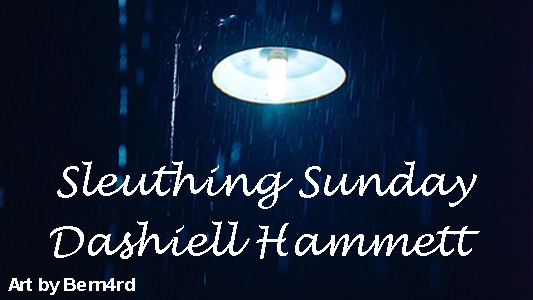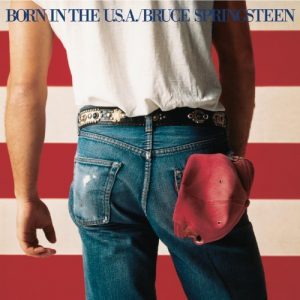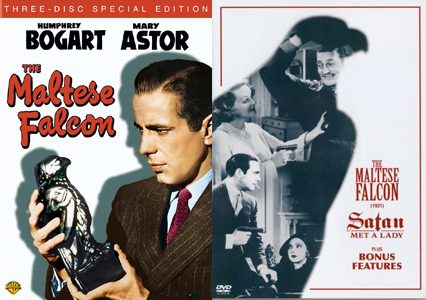We have a tendency to think history is simpler than it really is. It’s tempting to think Dashiell Hammett wrote “The Maltese Falcon” in 1930 and it smoothly transitioned into the 1941 Humphrey Bogart-starring film that’s a touchstone for American detective noir.
But Hollywood misfired twice before that – in 1931’s “The Maltese Falcon” and 1936’s “Satan Met a Lady.” (These versions are bonus features in the classic film’s three-disc DVD edition.)
A pair of misfires
Director Roy Del Ruth’s 1931 movie adapts Hammett’s plot faithfully but totally mishandles the hardboiled tone and characterizations. Ricardo Cortez plays Sam Spade as someone who is constantly putting on a show. He laughs at his little bon mots and delights at being a ladies’ man, even though his chemistry isn’t there with the women crawling over him. He’s often surprised by things as innocuous as a knock at the door, but at other times he projects confidence that’s too extreme for a street-beating sleuth. It’s a wildly uneven performance.

“The Maltese Falcon” (1931)
Director: Roy Del Ruth
Writers: Maude Fulton, Brown Holmes; Dashiell Hammett (novel)
Stars: Bebe Daniels, Ricardo Cortez, Dudley Digges
“Satan Met a Lady” (1936)
Director: William Dieterle
Writers: Brown Holmes (screenplay), Dashiell Hammett (novel)
Stars: Bette Davis, Warren William, Marie Wilson
“The Maltese Falcon” (1941)
Director: John Huston
Writers: John Huston (screenplay), Dashiell Hammett (novel)
Stars: Humphrey Bogart, Mary Astor, Peter Lorre
Dudley Digges plays Casper Gutman like the earliest version of the Penguin, more than a decade before “Batman” was invented. Bebe Daniels doesn’t have the intrigue or sensuality to make us believe she has made this near-goofball Spade fall for femme fatale Brigid. He’s a better match for giggly secretary Effie (Una Markel, arguably giving the film’s best performance).
The second adaptation, “Satan Met a Lady,” is no better, but it’s more interesting to watch and discuss. Director William Dieterle’s film is a half-century before its time, as it does the “Zero Hour”/“Airplane!” thing of taking an existing screenplay (the 1931 version by Brown Holmes) and exaggerating it for the sake of parody.
The execution by the actors is generally off-target, usually too broad, sometimes too understated – although again the Effie actress (Marie Wilson) is among the standouts, exaggerating the secretary’s dim-witted girlishness. The Spade stand-in (Warren William, who resembles “The Thin Man’s” William Powell with the popular thin mustache of the time) wears a perpetual grin below that ’stache.
“Satan Met a Lady” is a parody, but not a dry one like the Zucker Bros. works of 50 years hence. It’s more of a farce as the detective and his enemies tear up each other’s apartments and flash guns and money back and forth. It’s like that skit from “The Naked Gun” where Frank Drebin buys information from a dock worker, and the dock worker also buys information from Drebin. But over the course of a whole film, it’s exhausting.

Getting it right
Finally, in 1941, we got the definitive “Maltese Falcon,” written and directed by John Huston. Bogart doesn’t get the hardboiled charms of Spade precisely right; he smirks at his own wit too often and is sometimes too thoughtful with his delivery, rather than biting the words like Hammett intended. However, he’s 80 percent of the way toward the on-page Spade, and that’s better than Cortez getting 5 percent of the way there and William multiplying “The Thin Man’s” absurdities by 1,000.
Mary Astor doesn’t have the precise kind of beauty, chemistry or projected strength to fit with Bogart. I wonder if “Satan Met a Lady’s” Bette Davis might’ve been better, with huge eyes that a slightly vulnerable Spade might fall into. (Davis was of course required to play her version comedically – and a viewer can tell she’s not really into it — so my comparison is sheer guesswork.)
“Falcon” ’41 is faithful to Hammett’s work but classic scenes don’t jump from the page to our heartstrings as much as I wish them to – notably the monolog wherein Spade says he loves Brigid but doesn’t trust her. Still, Hammett’s dialog – retained by Huston – continues to sing.
Not as perfect as Hammett
Huston’s film also has more modern techniques such as a steady supply of music from Adolph Deutsch, drapes rustling in the breeze and shadows on office floors. “Falcon” ’31 has some of this, but undercuts it at every turn; for example, the breeze rustles Spade’s curtains, but then we see he’s wearing dot-patterned pajamas. Unless those dots are cigarette-butt burns, Cortez’s Spade ain’t hardboiled.
“Falcon” ’41 flows as smoothly as the “Star Wars”-style opening crawl explaining the titular statuette’s origins. By comparison, the 1931 version has several stock-still shots of newspaper clippings, written correspondence and location signage. And it doesn’t use music. It’s both stiff and schizophrenic.
“Falcon” ’41 isn’t as dripping with noir stylings as we might assume – there are no voiceovers and no rainfall. You’ll find the biggest downpour, oddly, in “Satan Met a Lady.” People who claim Huston’s “The Maltese Falcon” is the definitive film version are not all wet, though. Bogart and the technical professionalism make it easily better than its forebearers. But for perfection, you have to go back to Hammett.
Sleuthing Sunday reviews the works of Agatha Christie, along with other new and old classics of the mystery genre.
“The Maltese Falcon” (1931): 2 stars
“Satan Met a Lady” (1936): 2 stars
“The Maltese Falcon” (1941): 4 stars

